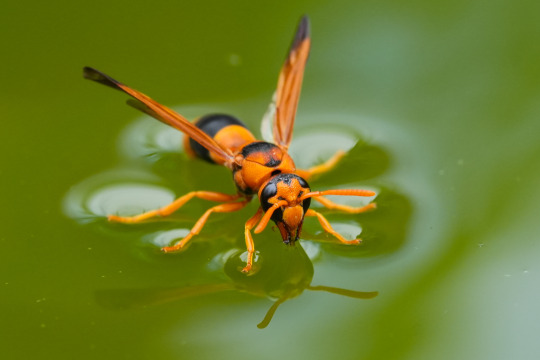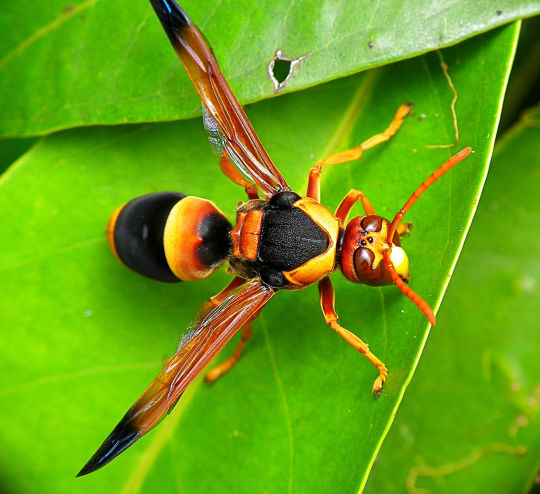#abispa ephippium
Text

my favourite visitor to the pond is this beautiful Australian Hornet (Abispa ephippium). she regularly comes to the pond to drink, and luckily isnt too camera-shy!

despite being called a hornet, A. ephippium is actually a species of potter wasp. as such, she is a solitary creature who spends her time building mud-nests to house her larvae, and hunting caterpillars with which to feed them. as an adult, she is a pollinator who feeds on flower nectar.

she is about 30mm (1.2in) in length, but deft enough to carefully land on top of the water without breaking the surface tension (so far she is the biggest insect I've seen thats able to do this). its an amazing behaviour from both an entomologic and photographic perspective, these photos are some of my favourites <3
Australian Hornet, female (Abispa ephippium).
#ljsbugblog#bugblr#entomology#insects#hymenoptera#vespidae#wasps#eumeninae#potter wasps#mason wasps#abispa#large australasian mason wasps#abispa ephippium#australian hornet#macro
2K notes
·
View notes
Text
#2154 - Pseudabispa bicolor ssp. bicolor

An East Coast species - Pseudabispa is an Australian and Papuan genus of potter wasps containing 5 species, with this one subdivided in 4 subspecies.
Pseudabispa wasps closely resemble mason wasps in the genus Abispa, and their distributions overlap. Although these two genera are among the largest solitary wasps in Australia, the biology of Pseudabispa was not well known until a 2010 study near Katherine, in Northern Territory. P. paragioides females were observed killing Abispa ephippium females, usurping their mud nests, stocking them with caterpillars stolen from still other nests, and closing the holes with mud taken from the host nest.
Uranquinty, NSW
4 notes
·
View notes
Photo

Australian hornet (Abispa ephippium)
The Australian hornet, actually a type of potter wasp or "mason wasp", is a vespid insect native to the Australian states and territories of the Australian Capital Territory, New South Wales, Northern Territory, Victoria, Queensland and Western Australia. The Australian hornet is a solitary insect, forming small nests against buildings and other structures. The adult wasp feeds off flower nectar, while the larvae are fed caterpillars captured by the female. A. ephippium is 30 mm in length. Being a member of the potter wasp subfamily (Eumeninae), A. ephippium females build large nests in sheltered positions using mud. The females search for prey (including spiders and caterpillars) around trees and shrubs, before sealing the captured insects inside the nest's cells. The larvae then feed upon these insects, before emerging.
photo credits: James Niland
#Australian hornet#Abispa ephippium#zoology#biology#biodiversity#science#wildlife#nature#animals#cool critters
270 notes
·
View notes
Photo

fat wasp doodle
9 notes
·
View notes
Text
#1359 - Pseudabispa - Fire-tailed Potter Wasp

David Wilson, South-east Queensland.
This genus of potter wasps found in Australia and Papua contains 5 species, with one (Pseudabispa bicolor) subdivided in 4 subspecies. This is probably one of them.
In morphology, size and coloration, Pseudabispa closely resemble mason wasps ( AKA ‘Australian Hornets’ ) in the genus Abispa, and their distributions overlap. Together they’re some of the largest wasps in Australia, but the biology of Pseudabispa is not well known. In 2010, a field study near Katherine, Northern Territory, strongly suggest that P. paragioides females attack and kill female A. ephippium and usurp their nests, and and further insult to injury by then appropriating the cells the late Abispa built, mass provision them with caterpillars acquired by theft from still other nests, and close them with mud taken from the host nest. They seem pretty fussy about who they’re kleptoparasitise too - there were three other species of large solitary wasps they could have harassed at the site, but focused all their attention on the unfortunate Abispa ephippium.
P. bicolor has also been seen around balls of dry mud in the base of hollow trees, that turn out to be very well camouflaged brood cells. But the Chews (of Brisbane Insects) couldn’t tell if the larva they found inside was a Pseuabispa, or another solitary wasp the False Australian Hornet intended to oust.
23 notes
·
View notes